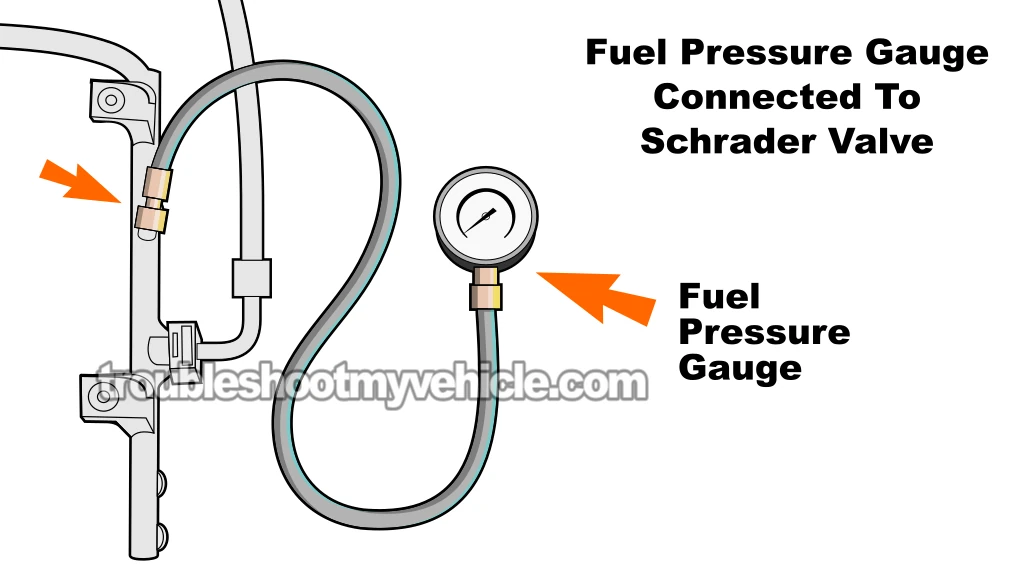
The fuel pump can be tested, to see if it's bad or not, with a fuel pressure test gauge.
In this tutorial, I'll show you how to do it. With your test results you'll be able to find out if the fuel pump is bad or not.
Contents of this tutorial:
- Symptoms Of A Bad Fuel Pump.
- Fuel Pressure Specifications.
- Where To Buy A Fuel Pressure Test Gauge.
- Fuel Pressure Test Gauge For Non-Schrader Valve Fuel Injector Rail.
- TEST 1: Checking Fuel Pressure With A Fuel Pressure Gauge.
- TEST 2: Using Starting Fluid To Confirm Lack Of Fuel.
- Fuel Pressure Release Procedure.
- More 5.2L, 5.9L V8 Dodge Ram Pickup Diagnostic Tutorials.
ES ![]() You can find this tutorial in Spanish here: Cómo Probar La Bomba De Combustible (1992-2003 5.2L, 5.9L Dodge Ram Pickup) (at: autotecnico-online.com).
You can find this tutorial in Spanish here: Cómo Probar La Bomba De Combustible (1992-2003 5.2L, 5.9L Dodge Ram Pickup) (at: autotecnico-online.com).
APPLIES TO: This tutorial applies to the following Dodge Ram pickups:
- 5.2L V8 Dodge Ram D150 Pickup: 1992, 1993.
- 5.2L V8 Dodge Ram D250 Pickup: 1992, 1993.
- 5.2L V8 Dodge Ram W150 Pickup: 1992, 1993.
- 5.2L V8 Dodge Ram W250 Pickup: 1992, 1993.
- 5.2L V8 Dodge Ram 1500 Pickup: 1994, 1995, 1996, 1997, 1998, 1999, 2000, 2001.
- 5.2L V8 Dodge Ram 2500 Pickup: 1994, 1995, 1996, 1997.
- 5.9L V8 Dodge Ram 1500 Pickup: 1994, 1995, 1996, 1997, 1998, 1999, 2000, 2001, 2002, 2003.
- 5.9L V8 Dodge Ram 2500 Pickup: 1994, 1995, 1996, 1997, 1998, 1999, 2000, 2001, 2002.
- 5.9L V8 Dodge Ram 3500 Pickup: 1994, 1995, 1996, 1997, 1998, 1999, 2000, 2001, 2002.
WIRING DIAGRAMS:
- Fuel Pump Circuit Wiring Diagram (1992-1993 5.2L, 5.9L V8 Dodge Ram Pickup).
- Fuel Pump Circuit Wiring Diagram (1994-1995 5.2L, 5.9L V8 Dodge Ram Pickup).
- Fuel Pump Circuit Wiring Diagram (1996-1997 5.2L, 5.9L V8 Dodge Ram Pickup).
- Fuel Pump Circuit Wiring Diagram (1998-2001 5.2L, 5.9L V8 Dodge Ram Pickup).
- Fuel Pump Circuit Wiring Diagram (2002-2003 5.9L V8 Dodge Ram Pickup).
ENGINE NO-START TESTS:
1989-1991 FUEL PRESSURE TEST:
Symptoms Of A Bad Fuel Pump
For the most part, fuel pumps usually fail in one of two ways: The fuel pump will fail completely and the engine won't to start. Or the fuel pump still functions but it doesn't send enough fuel to the fuel injectors.
When the fuel pump fails but sends just enough fuel to start the engine, you'll see one or more of the following symptoms:
- Rough idle.
- Engine starts after extended cranking.
- Lack of power when accelerating the vehicle down the road.
- Back-fires thru' the intake manifold when accelerating your vehicle down the road.
- Lean air/fuel mixture trouble codes: P0171 or P0174 or both.
Whether the fuel pump is the cause behind your Dodge Ram pickup's no-start problem or engine performance problem, you can find out with a simple fuel pump pressure test.
Fuel Pressure Specifications
| 1992 | |
|---|---|
| 5.2L | 39 PSI (Key On Engine Off -KOEO) |
| 5.9L | 14.5 PSI (Throttle Body Injection -TBI- System) |
| 1993 | |
|---|---|
| 5.2L | 39-41 PSI (Key On Engine Off or Key On Engine Running with vacuum hose connected to fuel pressure regulator) |
| 5.9L | 35-45 PSI (Key On Engine Running At Idle -No Load) |
| 1994-1995 | |
|---|---|
| 5.2L | 35-45 PSI (Key On Engine Running At Idle -No Load) |
| 5.9L | 35-45 PSI (Key On Engine Running At Idle -No Load) |
| 1996-1997 | |
|---|---|
| 5.2L | 44-54 PSI (Key On Engine Off) |
| 5.9L | 44-54 PSI (Key On Engine Off) |
| 1998-2000 | |
|---|---|
| 5.2L | 44-54 PSI (Key On Engine Running At Idle -No Load) |
| 5.9L | 44-54 PSI (Key On Engine Running At Idle -No Load) |
| 2001 | |
|---|---|
| 5.2L | 44-54 PSI (Key On Engine Off) |
| 5.9L | 44-54 PSI (Key On Engine Off) |
| 2002 | |
|---|---|
| 5.9L | 44-54 PSI (Key On Engine Off) |
| 2003 | |
|---|---|
| 5.9L | 47-51 PSI (Key On Engine Off) |
NOTE: If your Dodge Ram pickup does not start and there's only a key on engine running (KOER) fuel pressure specification, then that KOER specification will apply to your key on engine off (KOEO) fuel pressure test.
Where To Buy A Fuel Pressure Test Gauge
You can buy a fuel pressure test gauge just about anywhere and is one of the most important tools any serious DIY'er should have in his/her tool box.
The following fuel pressure test gauge kits are pretty good deals and will work with your Dodge Ram Pickup:
Disclosure: As an Amazon Associate, I earn from qualifying purchases. If my tutorials help you, using these links is an easy way to support the site at no extra cost to you. Thank you!
Fuel Pressure Test Gauge For Non-Schrader Valve Fuel Injector Rail
If your Dodge Ram Pickup's fuel rail does not have a Schrader valve, then the following fuel pressure test gauge will have the adapter you need:
Disclosure: As an Amazon Associate, I earn from qualifying purchases. If my tutorials help you, using these links is an easy way to support the site at no extra cost to you. Thank you!
TEST 1: Checking Fuel Pressure With A Fuel Pressure Gauge
Some Dodge Ram pickups (1996-1999 models) don't come equipped with a Schrader valve on the fuel injector rail.
On these models you can still connect a fuel pressure test gauge, but you'll need to use a special adapter. You can see what this adapter looks like in image 3 of 3 in the image viewer above.
FUEL RAIL WITH SCHRADER VALVE: If you don't have a fuel pressure gauge and would like to buy one, take a look at the section: Where To Buy A Fuel Pressure Test Gauge.
FUEL RAIL WITHOUT SCHRADER VALVE: The fuel pressure test gauge kit with the adapter you need isn't expensive. You can see it here: Fuel Pressure Test Gauge For Non-Schrader Valve Fuel Injector Rail.
IMPORTANT: On some Dodge Ram pickups (1996 to 2001), you'll need a scan tool to turn on the fuel pump and check fuel pressure. Don't have one? No problem. The steps below cover both situations —with or without a scan tool.
OK, let's get started with this test:
- 1
Place a shop towel around the Schrader valve. The shop towel's job is to absorb any fuel that may leak when doing step 2.
- 2
Connect the fuel pressure gauge to the Schrader valve (see image 1 of 3 and image 2 of 3).
Dodge Ram pickup without a Schrader valve:
A) Release the fuel pressure in the fuel line (see: Fuel Pressure Release Procedure).
B) Disconnect the fuel line from the fuel injector rail.
C) Install the fuel pressure gauge adapter between the fuel injector rail and the fuel line (see image 3 of 3 in the image viewer above). - 3
When ready, ask your helper to cycle the key on and off but don't crank the engine while you observe the fuel pressure tester's gauge.
Check the connection at the Schrader valve for fuel leaks and if any tighten the fuel pressure a bit more (by hand only) to eliminate them.
Key On Engine Running (KOER) Only:
- 4
Start the engine and let it idle.
- 5
The gauge should show the fuel pressure that matches your pickup's model and year.
Check the spec chart here: Fuel Pressure Specifications.
Key On Engine Off (KOEO) Without a Scan Tool:
- 4
Unplug the 2-wire connector from the ignition coil.
NOTE: This method applies only if your pickup has a KOEO spec listed. - 5
Crank the engine briefly, then release the key.
- 6
The fuel pressure reading should match the spec for your specific model and year.
You'll find the numbers here: Fuel Pressure Specifications.
Key On Engine Off (KOEO) With a Scan Tool:
- 4
Connect your scan tool to the diagnostic port (DLC).
- 5
Use the scan tool to turn on the fuel pump manually.
- 6
The pressure gauge should now show the correct reading for your pickup's year and model.
View the specs here: Fuel Pressure Specifications.
Let's take a look at what your results mean:
CASE 1: The fuel pressure gauge registered 0 PSI. This test result lets you know that the no-start problem is caused by a lack of fuel from the fuel pump.
I recommend that you take one more precaution, before condemning the fuel pump as bad, and this is to make sure that the fuel pump is getting 12 Volts as the engine is cranking. This is just to make sure that the fuel pump relay and fuse are OK and doing their job.
What you'll have to do to accomplish this is to attach a multimeter in Volts DC mode to the wire that supplies this voltage to the fuel pump and while a helper cranks the engine, verify that the fuel pump is getting this power. If the 12 Volts are being supplied to the fuel pump, you have now 100% verified that the fuel pump is fried and needs to be replaced.
CASE 2: The fuel pressure gauge registered less than the specified PSI. This test result lets you know that the fuel pump is failing.
CASE 3: The fuel pressure gauge registered the indicated PSI. This is the correct test result.
With this test result you can conclude that the fuel pump is working and delivering enough fuel to the fuel injectors. You can also conclude that your Dodge Ram Pickup is not starting due to another reason. The fuel pump is OK.
TEST 2: Using Starting Fluid To Confirm Lack Of Fuel

A quick and dirty way to check to see if a lack of fuel is causing a no-start problem is the starting fluid test.
This test simply involves spraying starting fluid into the engine and then cranking it to see if it starts.
If a lack of fuel is behind the engine's no-start problem, then it'll start and run for a few seconds (until the starting fluid is consumed).
It's important to note that using starting fluid to diagnose a fuel pump is not the most accurate way. Still, it's an effective test that'll get your fuel pump diagnostic started.
NOTE: To get an accurate test result from the starting fluid test, it's important that you make sure that all 8 spark plug wires are sparking.
IMPORTANT: This is a very fast and easy test but you do have to take one very important safety precaution and this is to reconnect the air intake duct back to the throttle body after spraying starting fluid down the throttle bore (although you don't have to fasten it). This will prevent any backfire, that might occur, from scaring the heck out of you when cranking the engine.
These are the test steps:
- 1
Remove the intake air duct from the throttle body. You don't have to completely remove it, since you'll have to reconnect it in one of the next steps.
- 2
Open the throttle plate and spray starting fluid down the bore.
As a safety precaution reconnect the air duct after you have sprayed a good squirt of starting fluid (but you don't have to tighten the air duct). - 3
Crank the engine once the air duct is back on and you're clear of the engine compartment.
- 4
You'll get one of two results with this test:
1.) The engine will start momentarily and after a few seconds will die.
2.) The engine will only crank but not start at all.
OK, let's analyze your test result:
CASE 1: The engine started and ran for a few seconds. This test result confirms that a lack of fuel is keeping your Dodge Pickup's engine from starting.
Your next step is to check to see what the fuel pressure is with a fuel pressure test gauge. Go to: TEST 1: Checking Fuel Pressure With A Fuel Pressure Gauge.
CASE 2: The engine did not start, not even momentarily. This usually means that a lack of fuel IS NOT the reason your car is not starting.
Now, remember what I said about this test not being very accurate? Well, I suggest you do one more test and this is to check the fuel pressure with a fuel pressure test gauge. Go to: TEST 1: Checking Fuel Pressure With A Fuel Pressure Gauge.
Fuel Pressure Release Procedure
Before installing the fuel pressure test adapter, on the fuel rail without a Schrader valve, it's important to first release the fuel pressure within the fuel line.
Here's the procedure that applies to the Dodge Ram pickups:
- Remove the fuel pump relay from the Power Distribution Center (fuse and relay box located in the engine compartment).
- Crank the engine. If the engine starts, let it run till it until it stalls.
- Crank the engine several times or until it won't start and run.
- Cover fuel line with shop towel and disconnect it from the fuel injector rail.
- The shop towel will absorb any residual fuel left in the fuel line.
- Re-install the fuel pump relay.
- When done with the fuel pressure test, clear any diagnostic trouble codes caused by cranking the engine without the fuel pump relay installed in the Power Distribution Center.
More 5.2L, 5.9L V8 Dodge Ram Pickup Diagnostic Tutorials
I've written quite a few 5.2L, 5.9L Dodge ‘how to test’ tutorials that may help you troubleshoot the issues on your Dodge Ram pick up. You can find them in these two indexes:
Here's a small sample of the articles/tutorials you'll find in these indexes:
- How To Test A No Start Condition (Dodge 3.9L, 5.2L, 5.9L).
- How To Diagnose Misfire Codes (Dodge 3.9L, 5.2L, 5.9L).
- How To Test The Fuel Injectors (Dodge 3.9L, 5.2L, 5.9L).
- How To Test The Ignition Coil -No Start Tests (Chrysler 3.9L, 5.2L, 5.9L).
- How To Test The MAP Sensor (P0107, P0108) (Dodge 3.9L, 5.2L, 5.9L).

If this info saved the day, buy me a beer!








